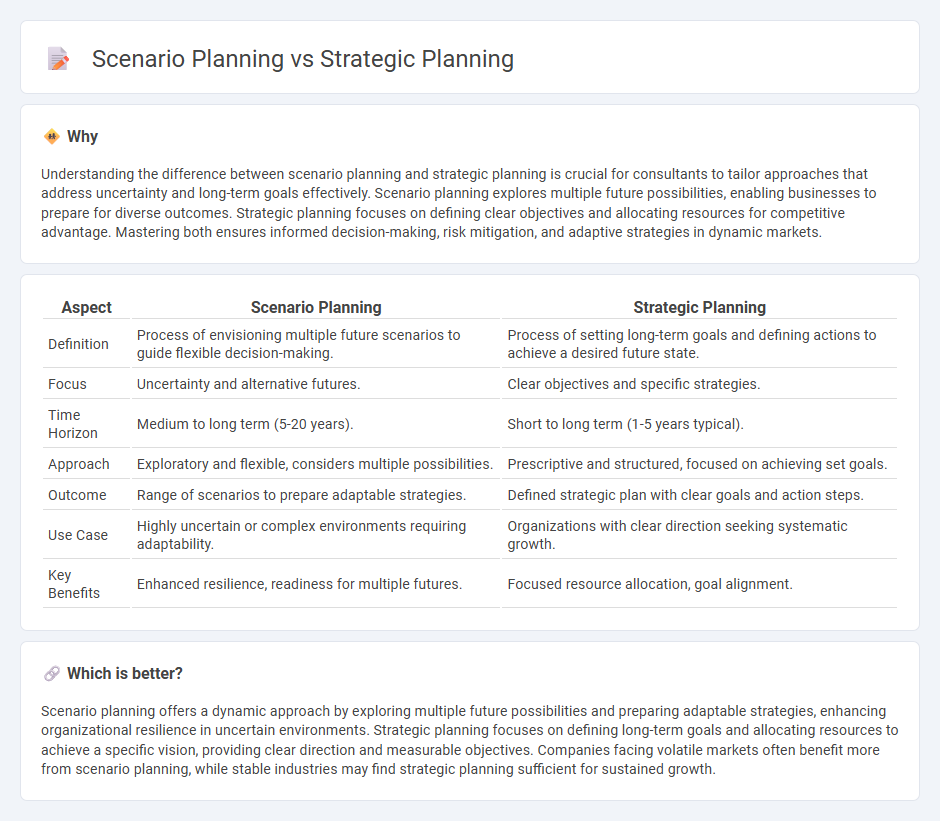
Scenario planning explores multiple future possibilities by analyzing uncertainties and developing flexible strategies, while strategic planning focuses on setting long-term goals and defining clear actions to achieve them. Organizations use scenario planning to anticipate potential risks and opportunities, enhancing adaptability in complex environments, whereas strategic planning provides a structured roadmap aligned with company objectives. Discover how integrating both approaches can strengthen your business resilience and drive sustainable success.
Why it is important
Understanding the difference between scenario planning and strategic planning is crucial for consultants to tailor approaches that address uncertainty and long-term goals effectively. Scenario planning explores multiple future possibilities, enabling businesses to prepare for diverse outcomes. Strategic planning focuses on defining clear objectives and allocating resources for competitive advantage. Mastering both ensures informed decision-making, risk mitigation, and adaptive strategies in dynamic markets.
Comparison Table
| Aspect | Scenario Planning | Strategic Planning |
|---|---|---|
| Definition | Process of envisioning multiple future scenarios to guide flexible decision-making. | Process of setting long-term goals and defining actions to achieve a desired future state. |
| Focus | Uncertainty and alternative futures. | Clear objectives and specific strategies. |
| Time Horizon | Medium to long term (5-20 years). | Short to long term (1-5 years typical). |
| Approach | Exploratory and flexible, considers multiple possibilities. | Prescriptive and structured, focused on achieving set goals. |
| Outcome | Range of scenarios to prepare adaptable strategies. | Defined strategic plan with clear goals and action steps. |
| Use Case | Highly uncertain or complex environments requiring adaptability. | Organizations with clear direction seeking systematic growth. |
| Key Benefits | Enhanced resilience, readiness for multiple futures. | Focused resource allocation, goal alignment. |
Which is better?
Scenario planning offers a dynamic approach by exploring multiple future possibilities and preparing adaptable strategies, enhancing organizational resilience in uncertain environments. Strategic planning focuses on defining long-term goals and allocating resources to achieve a specific vision, providing clear direction and measurable objectives. Companies facing volatile markets often benefit more from scenario planning, while stable industries may find strategic planning sufficient for sustained growth.
Connection
Scenario planning and strategic planning are interconnected processes that enhance organizational decision-making by anticipating future uncertainties and developing flexible strategies. Scenario planning generates multiple plausible future contexts, allowing strategic planning to create adaptive goals and initiatives aligned with potential market shifts. This synergy improves resilience and agility, enabling businesses to navigate complex environments effectively.
Key Terms
Vision Alignment
Strategic planning ensures vision alignment by setting clear, long-term goals that guide organizational decision-making and resource allocation, fostering a unified direction across teams. Scenario planning complements this by exploring diverse future possibilities and risks, enabling companies to adapt their vision proactively amidst uncertainties. Discover how integrating both approaches can strengthen your organization's vision alignment and resilience.
Contingency Development
Strategic planning centers on setting long-term goals and allocating resources based on predictable market conditions, while scenario planning emphasizes exploring multiple future possibilities to prepare adaptable responses. Contingency development within scenario planning builds flexible action plans for unexpected events, enhancing organizational resilience against uncertainties. Discover how integrating contingency development can strengthen your strategic approach by learning more about scenario planning techniques.
Long-term Objectives
Strategic planning centers on defining clear long-term objectives and allocating resources to achieve specific business goals over an extended period. Scenario planning explores multiple potential future environments to anticipate risks and opportunities, enhancing organizational adaptability. Discover how integrating these approaches can optimize your long-term success strategies.
Source and External Links
Strategic Planning Basics - Balanced Scorecard Institute - Strategic planning is the process of defining an organization's direction, priorities, and actions to achieve long-term success by clarifying mission, setting measurable goals, aligning resources, and tracking progress for accountability and growth.
What is strategic planning? | Definition from TechTarget - Strategic planning is a forward-looking process where leaders define the organization's vision, goals, and the sequence of achieving them to ensure alignment and progress toward the stated vision over several years.
Strategic Planning: What, Why, How, Tools, Templates | Gartner - Strategic planning maps the actions needed to deliver on long-term strategy, enabling proactive decision-making, resource alignment, goal communication, and adaptability in complex business environments for sustained success.
 dowidth.com
dowidth.com